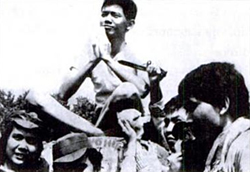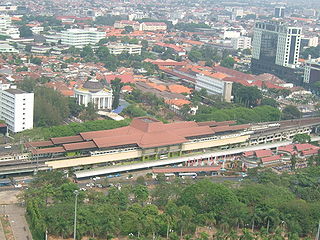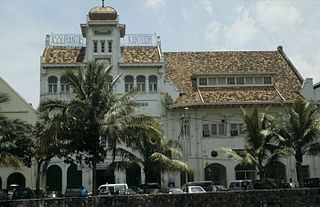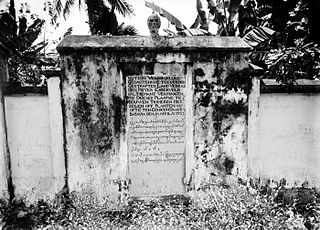
Jakarta, officially the Special Capital Region of Jakarta, is the capital of Indonesia. It lies on the northwest coast of Java. Jakarta is the centre of the economy, culture and politics of Indonesia. The city proper had a population of 10,562,088 as of 2020. Although Jakarta extends over only 699.5 square kilometres (270.1 sq mi), and thus has the smallest area of any Indonesian province, its metropolitan area covers 6,392 square kilometres (2,468 sq mi), and is the world's second-most populous urban area, after Tokyo. It has a population of about 35.934 million as of 2020. Jakarta's business opportunities, and its ability to offer a potentially higher standard of living than is available in other parts of the country, have attracted migrants from across the Indonesian archipelago, making it a melting pot of numerous cultures. Jakarta's nickname is "the Big Durian", after the thorny, strong-smelling fruit of that name that is native to the region. Calling Jakarta "the Big Durian" is seen as a nod to New York City's nickname, "the Big Apple".

Tanah Abang is a district of Central Jakarta, Indonesia. The district hosts the biggest textile market in Southeast Asia, Tanah Abang Market. Tanah Abang District is also the location of Bung Karno Stadium and the western half of the Sudirman Central Business District.

Soe Hok Gie was a Chinese Indonesian activist who opposed the successive dictatorships of Presidents Sukarno and Suharto.

West Jakarta is one of the five administrative cities which form the Special Capital Region of Jakarta, Indonesia. West Jakarta is not self-governed and does not have a city council, hence it is not classified as a proper municipality. It had a population of 2,281,945 at the 2010 Census; the latest official estimate is 2,589,933. The administrative center of West Jakarta is at Puri Kembangan. The current mayor is Uus Kuswanto.

Gambir is a district of Central Jakarta, Indonesia. It is characterized by many historic buildings from the colonial era. Gambir District is the location of many political and administrative center of Jakarta and Indonesia. The Merdeka Palace, the National Museum, the headquarters of the Indonesian Scout Movement and the Merdeka Square are located in Gambir.

Taman Sari is a district of West Jakarta, Indonesia. It is the smallest subdistrict of West Jakarta (4.37 km2). Taman Sari is bounded by Central Jakarta to the south and to the east, and by North Jakarta to the north.

The Jakarta History Museum, also known as Fatahillah Museum or Batavia Museum, is located in the Old Town of Jakarta, Indonesia. The building was built in 1710 as the Stadhuis of Batavia. Jakarta History Museum opened in 1974 and displays objects from the prehistory period of the city region, the founding of Jayakarta in 1527, and the Dutch colonization period from the 16th century until Indonesia's Independence in 1945.

The Wayang Museum is a museum dedicated to Javan wayang puppetry. The museum is located in Kota Tua, Jakarta, Indonesia. It is one of several museums and galleries facing the Fatahillah Square, which include Jakarta History Museum, Fine Art and Ceramic Museum, and Kota Post Office art gallery.

The following is an alphabetical list of topics related to the Republic of Indonesia.

Olivia Mariamne Devenish, was the spouse of Thomas Stamford Raffles, vice governor of Java (1811–1816), from 1805 to 1814. A memorial monument was erected to her memory in the botanical garden of Buitenzorg (Bogor).
The following is a timeline of the history of the city of Jakarta, Indonesia.

Radya Pustaka Museum is a museum in Surakarta, Indonesia. Established in 1890, it is the second oldest museum in Indonesia. The museum kept various literature in Old Javanese and Dutch languages. The museum is located within the park complex of Taman Sriwedari.

Pieter Erberveld was a Eurasian resident of Batavia, Dutch East Indies, the headquarters of the VOC in Asia, during the 17th and early 18th centuries who was accused of plotting a rebellion with Javanese for January 1, 1722, but was captured and executed, and a monument erected where his house had stood.

Fatahillah Square is the historical center of the old Batavia. The square is located at the center of Jakarta Old Town. Today the square is a tourist area home to the Jakarta History Museum, Wayang Museum and Fine Art and Ceramics Museum in Kota, Jakarta.

Ciaruteun inscription also written Ciarutön or also known as Ciampea inscription is a 5th-century stone inscription discovered on the riverbed of Ciaruteun River, a tributary of Cisadane River, not far from Bogor, West Java, Indonesia. The inscription is dated from the Tarumanagara kingdom period, one of the earliest Hindu kingdoms in Indonesian history. The inscription states King Purnawarman is the ruler of Tarumanagara.
Sophia Hull was the second wife of Sir Stamford Raffles, the founder of modern Singapore.

The following outline is provided as an overview of and topical guide to Jakarta:

Si Jagur or Ki Jagur is an old cannon of Portuguese heritage which is located in the Jakarta Fatahillah Museum.



















